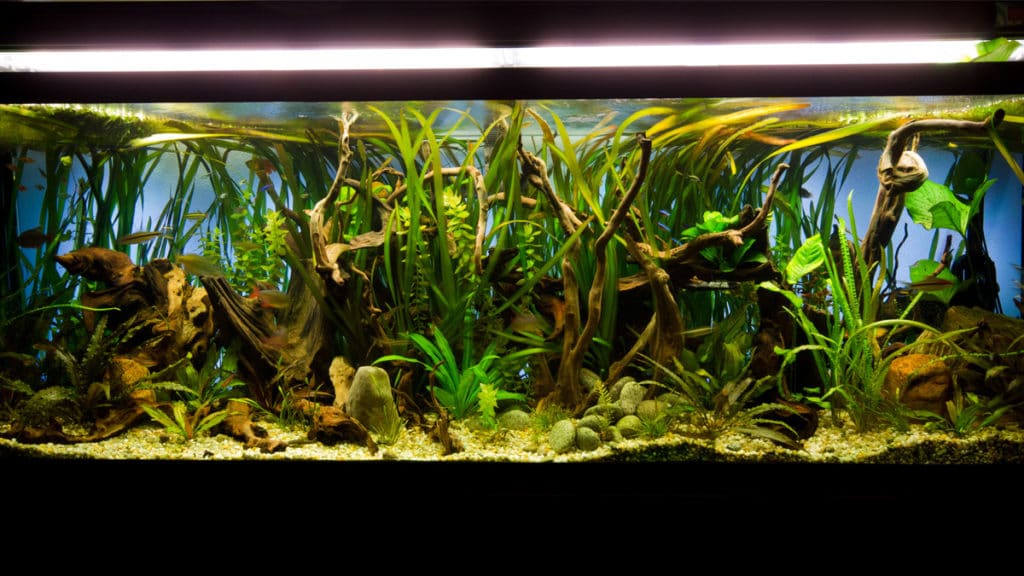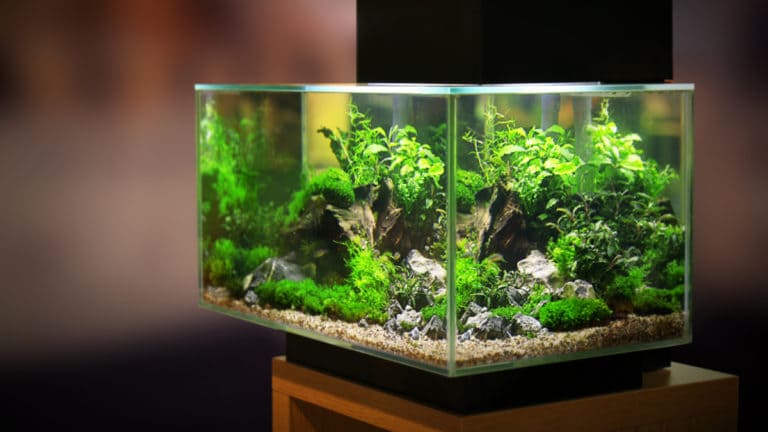In nature, fish and aquatic plant life experience varying amounts of light and darkness. To keep the fish and plants in your aquarium healthy, you need to match their natural lighting conditions as closely as possible with aquarium lighting, according to Dr. Julius Tepper of Long Island Fish Hospital.
Factors that affect lighting choices are the size of the aquarium, whether it’s saltwater or freshwater, and the type of fish and plants in the aquarium. Too little light can stunt the growth of your fish and plants. Too much light can cause the growth of excessive algae, which increases aquarium maintenance requirements.
Because natural light changes with the seasons, your aquarium lighting also needs to change. Seasonal variation is most important for cold water aquarium fish, which live with the greatest daylight fluctuation in nature. An easy way to adjust lighting is to use a power strip with a timer.
Tepper notes that mimicking the environment where your fish evolved has become much easier and more affordable using LED lighting and highly sophisticated components to control the lighting.
Here are the basics of what you need to know about aquarium lighting.
The Light Spectrum and Light Intensity
Two important factors for fish aquarium lighting are the light spectrum and the light intensity. Light spectrum and intensity in a natural aquatic setting vary depending on factors such as water depth, water clarity, air clarity and weather.
You want to match the spectrum and intensity of your aquarium lighting as closely as possible to the native environment of your fish and plants. You do have more leeway for fish than for plants.
The visible light spectrum ranges from violet at a wavelength of about 380 nanometers to red at a wavelength of about 700 nanometers. The spectrum of an aquarium light bulb is described by a Kelvin Rating, also called K rating. This number describes the color temperature the bulb emits. Bulbs with a lower K rating emit a warmer, reddish light, while bulbs with a higher K rating give off a cooler, bluish light. For reference, noon daylight is around 5,500 K. Most aquarium lights have a Kelvin rating between 5,000K-20,000K.
Because the rating of sunlight at sea level is around 5,500K, a bulb with this rating works well for shallow-water aquarium plants and fish. As the depth of the native habitat of your fish and plants increases, you need lights with a higher K rating.
Bulbs with a 20,000K rating mimic deep-water environments. You can also use actinic bulbs, which produce the mostly blue light needed to provide energy for photosynthetic growth of coral. However, some people find blue actinic lighting unpleasant and choose 50/50 bulbs. These bulbs are 50 percent of a specified K rating and 50 percent actinic.
Compared to spectrum, light intensity is simpler: It’s measured in watts. More watts provide more intense light.
Aquarium Lighting Guide
Let’s look at different types of aquarium light bulbs and their properties, advantages, disadvantages and recommended uses.
Incandescent bulbs
- Properties: 7-25 watts, last for 2-4 months, Kelvin rating depends on the color of bulb.
- Advantages: Inexpensive and available in multiple colors.
- Disadvantages: Provide a narrow spectrum, have low-light intensity and produce a lot of heat.
- Recommended Use: Use these bulbs only for small fish and in a beginner’s startup aquarium
Standard fluorescent bulbs
- Properties: 15-40 watts, last 6-18 months, Kelvin rating of 3,000K-20,000K, and actinic bulbs are available.
- Advantages: Available in a wide range of colors and sizes, efficient, cool and inexpensive.
- Disadvantages: Not suitable for photosynthetic plants or
- Recommended Use: Use these bulbs for fresh and saltwater fish-only aquariums or for mini or micro reef with low-light corals and Standard fluorescent works well for cold water aquarium fish.
Compact fluorescent bulbs (higher light output versions of standard fluorescents)
- Properties: 10-130 watts, last 12-28 months, Kelvin rating of 5,000K-10,000K, and actinic bulbs are available.
- Advantages: These long-lasting bulbs offer high light intensity and a wide spectrum.
- Disadvantages: May produce high heat and require a chiller.
- Recommended Use: Use these bulbs for a reef less than 24 inches deep, freshwater-planted aquariums and marine aquariums.
T-5 HO (high output) fluorescent bulbs
- Properties: 24-54 watts, last 16-24 months, Kelvin rating of 6,000K-11,000K, and actinic bulbs are available.
- Advantages: These high-intensity bulbs are small and cool.
- Disadvantages: Don’t work well for aquariums more than 24 inches deep.
- Recommended Use: Use these bulbs for a reef less than 24 inches deep and freshwater-planted aquariums.
VHO (very high output) fluorescent bulbs
- Properties: 75-165 watts, last 4-18 months, Kelvin rating of 10,000K and actinic bulbs are available.
- Advantages: Many sizes are available.
- Disadvantages: Produce high heat and may require a chiller.
- Recommended Use: Use these bulbs for a reef less than 24 inches deep and freshwater-planted aquariums.
Metal halide bulbs
- Properties: 70-1,000 watts, last 6-18 months, Kelvin rating of 4,000K-20,000K.
- Advantages: These bulbs offer the highest intensity light for aquariums and have a wide spectrum, making them a good choice for aquariums that require high-light conditions.
- Disadvantages: Produce high heat and may require a chiller. Since the bulbs may generate lots of heat and emit ultraviolet radiation, they require special handling to prevent injury to your skin or eyes.
- Recommended Use: Use these bulbs for reefs or freshwater aquariums more than 24 inches deep and for photosynthetic corals and invertebrates.
LED (Light-Emitting Diode) bulbs
- Properties: 05-5 watts, last up to 50,000 hours and Kelvin rating varies depending on the LED array.
- Advantages: LEDs are the most energy-efficient lighting. These long-lasting lights help lower aquarium maintenance.
- Disadvantages: LEDs are sensitive to heat You must have proper ventilation and keep LEDs away from hot lights or devices.
- Recommended Use: Use LED lights as accent light, for supplemental light or as the main light source for all freshwater and marine aquariums, including coral reef aquariums. The best saltwater LED lights provide uniform lighting and can simulate a sunrise, sunset and moonlight. You can also buy LED arrays with decorative features.
The right lighting in your fish’s aquarium can improve your pet’s quality of life and ensure their well-being. With all the available aquarium lighting options, you can create a healthy environment for your fish and plants while also crafting a decorative showpiece for your home.
Share:













